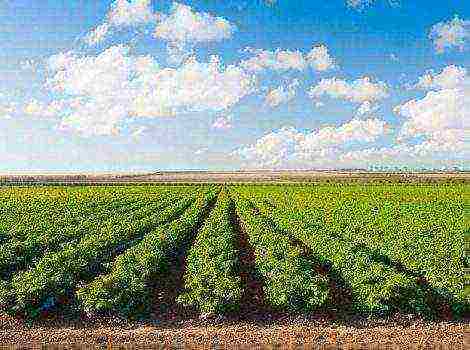The beautiful delicate plant magnolia kobus evokes a special charm in spring, with its fragrant large flowers
Magnolia - a tree of unique beauty
The beautiful delicate plant magnolia kobus evokes a special charm in spring, with its fragrant large flowers, and during the growing season attracts the eye with unusual decorative leaves and very bright fruits.
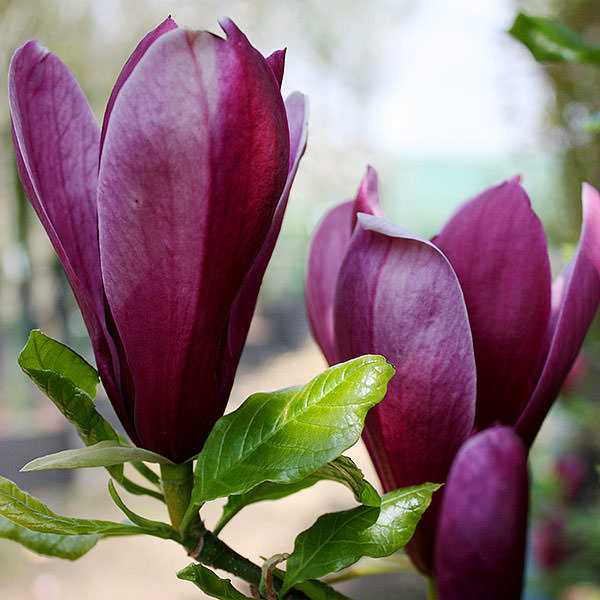
Magnolia is propagated by a seedling or cuttings, but this tree can also be grown from seeds. This process is laborious and requires a lot of effort and care from the gardener.
How to germinate magnolia seeds
Before planting, the seeds of magnolia must be peeled off. To do this, the seed is left at room temperature for a while, when the seeds fall out, they are immersed in water for 2-3 days. Swollen seeds, for better cleansing, need to be wiped through a sieve, then washed in soapy water (use only laundry soap). This is done in order to rid the magnolia seeds of oiliness, then they must be thoroughly washed from soapy water, if these procedures are not carried out, then most likely they will become moldy.
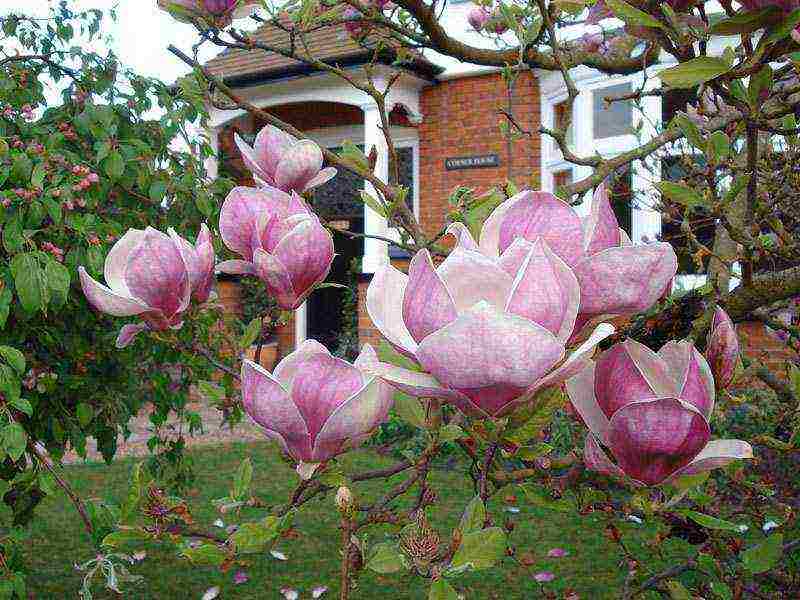
Planting magnolia
Choose a place for replanting a plant in a high place without stagnant water. The plant does not tolerate getting wet and weeds out. Magnolia seeds can be sown outdoors with at least 10cm deep furrows.
Crops for the winter are insulated with dry mulch or leaves with a layer of 20-25 cm. In the spring, the insulation is removed together with the top layer of soil to a sowing depth of 3-5 cm. If the soil is left unchanged, the seedlings will lag behind in the first year.
The best option is to sow the magnolia seeds in a deep container of soil around December. The depth of the container is important, since the plant has a long taproot, and if there is not enough space for its development, the plant will wither. Water abundantly and cover on top to prevent the soil from drying out. Store the container in a basement with a temperature of 0 +5 degrees. In early spring, you can move to a warm, bright room. Seedlings are planted in open ground in the second year, magnolia should be watered very carefully, since in the early vegetative period the plant is susceptible to the disease "black leg".
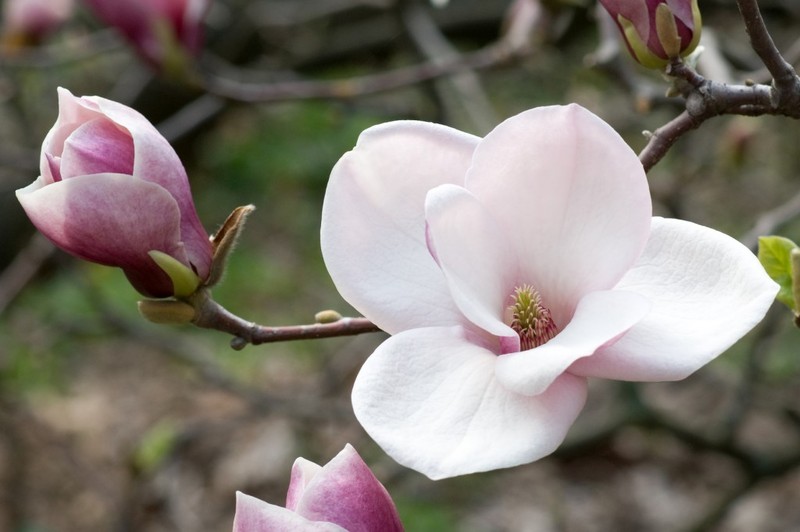
Home care
Magnolia loves permeable fertile soil. It is preferable to choose a place in the garden in partial shade and protected from server winds. Magnolia kobus blooms, grown from seeds for 8-12 years. Although magnolia kobus tolerates winter very well, however, the first two wintering periods, after planting the tree in open ground, must be insulated with dry material, and the crown must be furnished with branches of spruce branches in the form of a hut, or carefully wrapped with covering material.
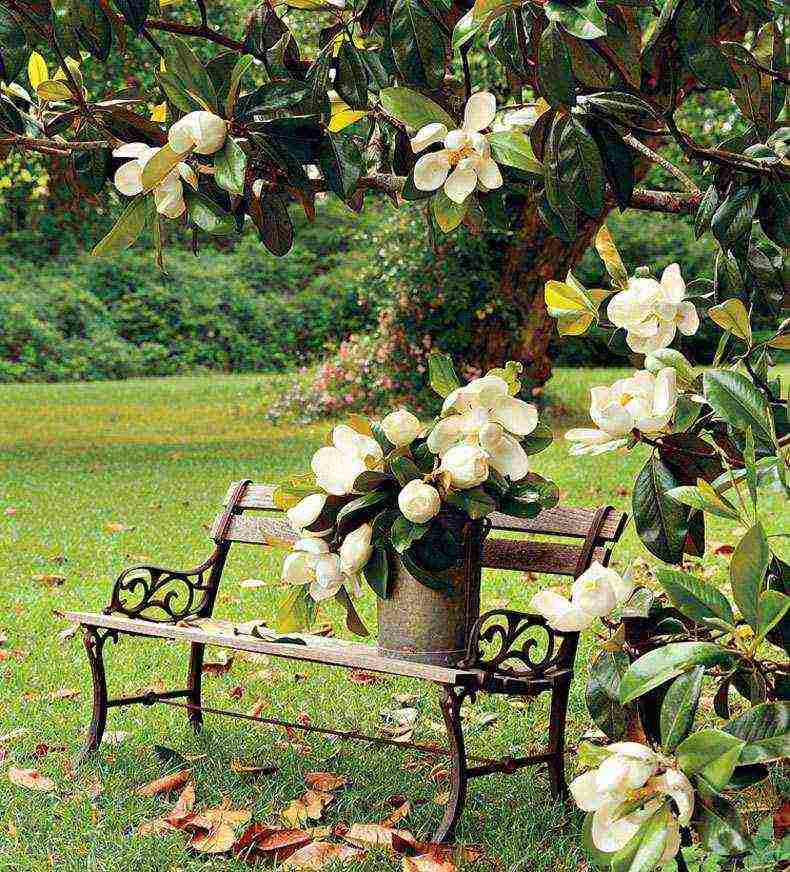
If the top of the plant "grabs" in the cold, then in the further process of growth a bush will form, not a tree. If the seedling has not yet been planted in the ground, it is brought into the basement, it can be stored on a glazed balcony, but the pot should be insulated.
Following the recommendations and taking into account the peculiarities of care, you can get the result of the pride of any gardener, in the form of the unique beauty of a tree grown with your own hands.
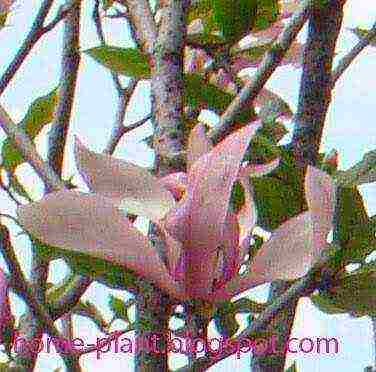 |
| Magnolia |
When I admired the large fragrant flowers - "water lilies" of this magnificent tree floating among the heavens, I lamented why it was not grown in an apartment. But! It turned out to be exotic magnolia (Magnolia) is also referred to as ... indoor plants. How does a magnolia behave at home? Let's find out about this right now.
"I drink coffee in the magnolia garden!" Caring for Magnolia at home
The method of growing in a tub has a number of advantages - especially for latitudes with northern climates. This plant does not need to be wrapped up for the winter - and there is no risk that it will freeze. But, as they say, each method has its own drawbacks.The room for this blooming splendor should amaze with its breadth of scope. To maintain this tree (or shrub), you will need, rather, not a room - but a spacious winter garden or a huge hall with high ceilings. In an ordinary apartment, you can grow undersized magnolias. Or very young specimens - in order to later move them to the territory "in proportion".
But even small shrubs will require spacious flowerpots. Large pots are a prerequisite for growing this exotic.
But in general, this green friend ... is very unpretentious. He adapts quite well to home conditions. So, it puts up with the dryness of the air, it can also tolerate partial shade.
But for the successful growth of magnolia, bright light is needed.... Even in the garden, it is recommended to plant it in a well-lit space. And in the apartment she needs to highlight the brightest place in the sun.
This spectacular plant needs to be transplanted only by the transshipment method - after all, it has a sensitive root system that is easy to disrupt..
Also, in the summer, she will need abundant watering. In this case, the water should be soft and settled. Like most of our green pets, this flora does not react well to lime. In winter, when the air temperature drops, irrigation will have to be reduced slightly. But if the room is warm and light, you should also water generously.
Another important condition is feeding during the growing season with fertilizer 2 times a month and protection from drafts in winter.
That's all the wisdom. In fact, the conditions for this exotic are practically the same as for most domestic plants.
And for those who believe that this beauty is useless, it will be interesting to know: large-flowered magnolia (Magnolia grandiflora) is a medicinal plant. In particular, the infusion of its leaves is used to lower blood pressure and to treat heart disease.
It is also a great myth that all magnolias shed their leaves. There are also evergreen species that are suitable for those who are sad to look at a bare trunk in the apartment in winter.
Where to buy magnolia?
Her seedlings are sold in the Botanical Gardens, as well as in many green nurseries and even large flower shops. But many growers prefer to grow Magnolia from seed. It's not that hard - and much cheaper. In addition, a plant grown from seed is twice as dear to the heart of flower lovers.
As soon as you hear the name of the delicate magnolia flower, a picture of the resort, a warm sea breeze, the smell of grilled meat and exotic plants appear in front of your eyes. This flower takes the most noticeable place among the riot of aromas. It is hard to miss because of its large white leaves.
In nature, there are 80 different types of magnolias, among which there are both evergreen and deciduous plants.
Most of the varieties can be grown without restrictions, the only obstacle is the too dry climate. Each type of magnolia has its own lifespan: some will delight only seven years, others - 20-30.
Care and cultivation
Magnolia is not a picky shrub. Soils for growing this plant can be different:
- black earth;
- lungs;
- loamy.
Magnolia loves acidic soils. And if the PH of the soil is close to a low level or neutral, then it needs to be acidified.
You may not be puzzled by this problem, but for the shine of the foliage and color saturation, it is worth moistening the bush several times a season with water and citric acid.
Magnolia will not benefit from a significant amount of lime in the soil or the proximity of groundwater. Despite the fact that the shrub prefers frequent watering, especially in the dry season, she does not like waterlogging of the root system.
Magnolia of the Kobus variety is often grown at home. This tree reaches 25 cm. Its homeland is the Japanese island of Hokkaido.
In the local climate, this species can reach 5 meters and live for 30 years.The tree is covered with cute cupped buds even before the foliage blooms.
It is very lucky for those who are pleased with the star-shaped magnolia in the garden. Under natural conditions, a plant of this species is found in Japan on the island of Honshu, in the humid forests of the mountains.
In such conditions, the shrub can reach three meters in height, with very beautiful flowers up to 12 cm in diameter.
One inflorescence of white or pink color can have up to 15 petals. At a young age, the bushes need protection from harsh winters. In a fairly adult state, they firmly endure moderate frosts and continue to bloom in April until the foliage blooms.
No less beautiful is Lebner's magnolia, which is a hybrid of the aforementioned cobus and star-shaped varieties. This tree can please a gardener for 27 years. Its height reaches 5 meters in height.
Magnolia Lebner blooms beautifully and gives ripe seeds. The flowers are divided into 9 petals, white and pink, and are flat, 15 cm in diameter. In severe frosts, this variety can freeze the buds, which can affect the degree of flowering in spring.
In addition to the varieties mentioned, it is also worth remembering the beautiful magnolias:
- Sulange;
- Lilietzvetkova;
- Naked;
- Kyuvensky.
Magnolia breeding methods
This tree can be propagated by seed and vegetative propagation. The fruit of a magnolia is a multileaf, which resembles a cone or curved pod.
When the ripening time comes, the fruit cracks and the seeds are exposed. They are in a meaty membrane, which must be removed before planting. The soft coating should soften and turn brown.
If the seeds become moldy during storage, then they will no longer be suitable for planting.
Magnolia seeds are heart-shaped. They are placed in a substrate of sand and peat and sent to the basement for stratification. The soil is kept moist, with little oxygen access. Seeds are sown in April on a darkened area, deepening by 3 cm.
The grown magnolia seedlings in the first three years need to be covered for the winter. For these purposes, you can use:
- spruce branches;
- agrofibre or dry foliage.
In the event that the seedlings were grown all the time in seedling boxes, then they can be brought into the greenhouse for the winter.
Magnolia - a tree that gives a heady and delicious scent of lemon and vanilla, in the land of the rising sun is a symbol of chastity. This flowering shrub is equally loved in our country.
The sight of a blooming magnolia explains the love for the tree and the desire to have it in your garden or backyard. Trees can be pyramidal or spherical, which makes it possible to perfectly fit them into any landscape.
How is a magnolia planting with a seedling
When choosing a suitable seedling, first of all, you should pay attention to its root system, which must be closed. The site on the site is allocated protected from winds, without stagnation of moisture and the proximity of groundwater.
Magnolia has a poorly developed root system, so it is a vulnerable spot and can lead the tree to death.
If the seedling is planted in resort areas with a bright sunny climate, then it is worth choosing places with a slight darkening. The best time to plant magnolias is in autumn. At this time, young trees stop growing and root better.
Spring planting in April is opposed by those gardeners who argue that even small return frosts can destroy a young magnolia shrub.
The magnolia planting hole should be three times larger than its root system. The soil should be enriched with humus and sand. The root collar on the seedling is not covered with soil during planting.
If magnolia seedlings grow very slowly in the first years, then you can get fast growth through layering from the mother tree.
Layers are traditionally made by bending the young shoot to the ground, pinning it with a staple and sprinkling it with soil on top.In autumn, the cuttings with the root system are separated from the mother tree and looked after as an independent plant.
Magnolia does not grow in many regions as it loves tropical climates. There are no prohibitions for flower growers - they can always be grown at home, creating favorable conditions for him.

Description and features of magnolia
Natural specimens of magnolias fascinate with their beauty and impressive crown. Height magnolia tree can reach under favorable conditions up to 15 meters.
Large pink-white buds, in the form of cups, like floating "water lilies" are located at the tips of the branches. The delicate vanilla-lemon scent of the tree is felt from afar.
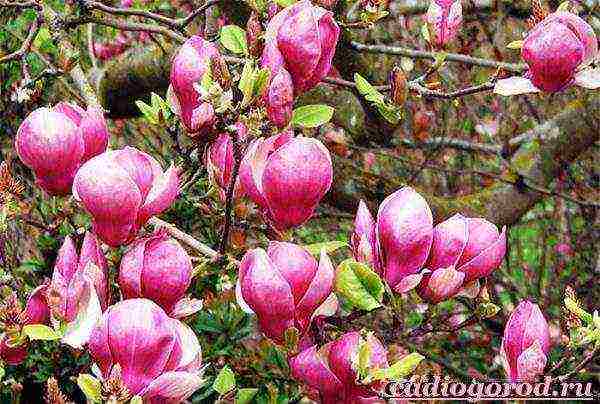
The oldest genus of magnolias, to which magnolias belong, includes 240 species. The bark of a tree or shrub is brown or ash-colored. At home, the plant is grown as a bansai.
On the photo of magnolia flowers compact variety Bracken's Brown Beauty stands out with special tenderness against the background of large dark green leaves. The leaves are oval with a sharp end, the surface is leathery and smooth. Below they are covered with a rusty shade of fluff. Their life path is short. From time to time they are replaced by young leaves.
The fruit looks like a pine cone. The seeds are covered with a red fleshy skin. Among indoor crops, the most popular varieties can be distinguished: Litle Grem, Magnolla Figo, Hasse, Magnollf coco.

In the photo, the fruit of magnolia
Planting and breeding magnolias
Magnolia flower light-loving plant, in the room you need to choose the sunniest place for it, for example, the south or west side of the room. The plant propagates in a vegetative and seed way.
Cuttings:
-
a bush whose age is 1 year is most suitable for propagation by cuttings. Rooting is ensured by 90%;
-
the best time is spring-autumn;
-
semi-lignified branches of 15-20 cm are cut off from the crown, freed from excess leaves. The stalk remains with two leaves. They will feed the stem before rooting;
-
green twigs are not used for divorce, since rooting is almost impossible;
-
it is better to plant them in a container in several pieces, treat the bottom with a root former;
-
substrate: perlite, vermiculite, peat;
-
now we need to create a greenhouse effect at home. To do this, place the container in another transparent container with opening and closing valves at the top. This will make it possible to ventilate the seedlings.
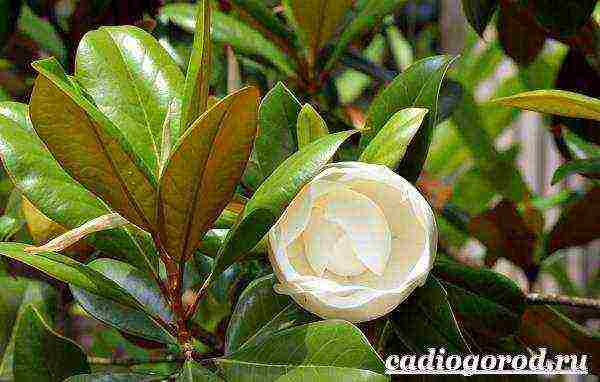
-
keep the temperature in the greenhouse at 22-24 degrees C. You can use the bottom heating. Cuttings will die if the temperature rises to 26 degrees C and drops below 18 or the substrate dries up;
-
the soil can be replaced with peat tablets;
-
rooting will occur in 7-8 weeks. Cuttings are transplanted into pots;
-
when using peat tablets, the stalk is planted with it.
Horizontal layering:
-
put a flowerpot next to the flower and dig the lower part of the branch into the ground;
-
press down with a piece of wire or a hairpin;
-
after 1-2 years the roots will appear;
-
the bush is separated from the mother tree, and it grows on its own.

Seeds:
-
before sowing seedlings, preparatory work must be carried out;
-
to free them from seedlings, it is enough to spread the seeds on a napkin;
-
as soon as they are cleaned, fill the seedlings with water for 3 days;
-
at the end of the term, release the fruits from the shell (sarcotests);
-
rinse thoroughly under running water with a detergent so that there is no oily plaque;
-
treat with fungicides before sowing;
-
substrate: peat, garden soil in a ratio of 1: 2;
-
planting material in a container and cover with polyethylene material;
-
a large layer should be poured in the soil container so that it does not dry out quickly;
-
if the seeds will be planted in open ground, stratify. Soak in a humid environment, such as sphagnum moss, until sprouts appear. Keep in the refrigerator;
-
reproduction magnolia flower at home this is not required, the seeds are planted immediately after collection;
-
the temperature is maintained at 20-25 degrees C;
-
remove the film at the first shoots;
-
the signal for transplanting into separate pots is the appearance of 2 leaves.
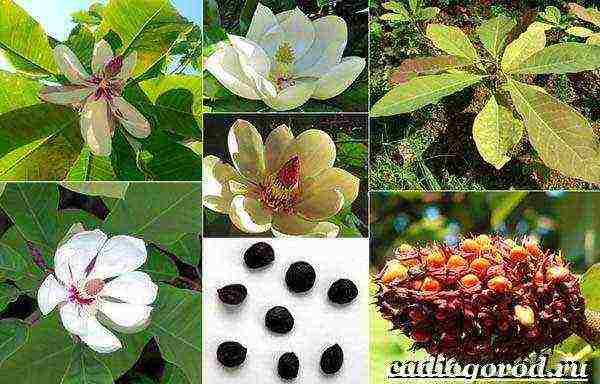
Magnolia care at home
-
Soil for blooming magnolias should be slightly acidic and moisture permeable. Use sphagnum moss and charcoal as drainage.
-
Home flower magnolia has a powerful root system. Therefore, choose large pots for him. It's a good idea to plant them in tubs in order to put them on the terrace in the summer.
-
The plant responds positively to loosening. To maintain moisture, the top layer of the flowerpot can be mulched.
-
Keep the humidity in the room at 60%. It can be increased by spraying around the plant.
-
Indoor flower magnolia loves abundant watering. Use soft and settled water. It is better if it is filtered.
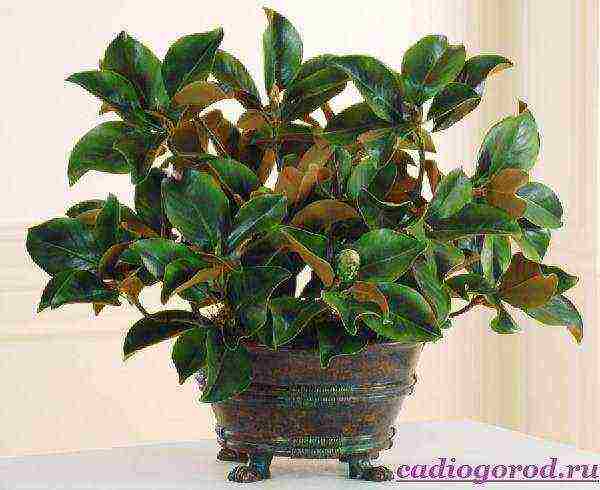
-
Only sanitary pruning is required.
-
Do the transplant as needed. Although the root system is powerful, it is very fragile and vulnerable. Plants are transplanted using the transshipment method. The contents are carefully removed from the pot along with a lump of earth. Before the procedure, spill the soil so as not to damage the roots. Sometimes it is better to take the top layer of the earth and renew it with a new one.
-
Choose a pot 2 cm in volume more than the previous one.
-
The flower is resistant to all diseases, except for verticillosis. Symptoms: the lower leaves fade and turn yellow at the first stage, then the upper ones. The causative agent of the disease is the fungi Verticillium. More often garden specimens are exposed to such infection. Control methods - treatment with the drug "Fundazol".

-
Protect from drafts in winter, provide cool air. Keep in a consecrated place. Reduce watering.
-
Feed during the growing season. Fertilizers for "magnolias", "azaleas", "rhododendrons" should be applied once every 2 weeks.
Buy magnolia flower it is possible in the flower shop, the Botanical Garden, order through the online store. Wherein magnolia price varies from 1,500 rubles.
Many growers prefer not to spend money, but to grow them from seeds, which cost 250 rubles. Before growing these flowers in the house, you should think about whether family members are allergic to flowers. They have a surprisingly strong aroma.

